Swamp Milkweed, Western Swamp Milkweed, Pink Milkweed, Eastern Swamp Milkweed - Asclepias incarnata
|
Asclepias incarnata - Swamp Milkweed, Western Swamp Milkweed, Pink Milkweed, Eastern Swamp Milkweed. Asclepias (Milkweed) is a large genus, with around 100 species total, and over 75 in the United States. There is at least one species in every state except for Alaska. Milkweed is important if for no other reason than the fact that the Monarch butterfly only lays its eggs on Milkweed plants, and the Monarch caterpillar only eats the leaves of the Milkweed plant. The genus was named for the Greek god of medicine, Aesculapius.
Asclepias incarnata is one of the more widely distributed species of Milkweed, being found in all but six states. It is rare in Nevada, Montana, Arkansas, and Louisiana. It is not found in Alaska, Hawaii, the west coast states of Washington, Oregon, and California, and is also missing from Mississippi. Note that the USDA Plants Database map shows it missing from Arizona, but the BONAP map, which is usually more current, shows it in that state. It is found in swamps and marshes and other usually wet areas, explaining its rarity in states that are largely desert. There are two recognized varieties (or subspecies) of A. incarnata - var. incarnata - Western Swamp Milkweed - and var. pulchra - Eastern Swamp Milkweed. Var. incarnata is by far the more widely distributed variety. Var. pulchra is hairier, has broader leaves, and the leaf bases are more rounded or even nearly cordate. It also is less branching than var. incarnata, and its distribution is, as implied by that common name, more eastern.
Found in:
AL, AR, AZ, CO, CT, DC, DE, FL, GA, IA, ID, IL, IN, KS, KY, LA, MA, MD, ME, MI, MN, MO, MT, NC, ND, NE, NH, NJ, NM, NV, NY, OH, OK, PA, RI, SC, SD, TN, TX, UT, VA, VT, WI, WV, WY
Leave comments on Asclepias incarnata at this link. | 
Distribution of Asclepias incarnata in the United States and Canada:

Map courtesy of The Biota of North America Program.
Map color key
Search Our Database: Enter any portion of the Scientific, Common Name, or both.
Do a general Google search of the entire site:
#ad
 Follow USWildflowers on Twitter
#ad
| | Site: I-64 Gateway Rest Area, St Clair County, IL Date: 2016-August-23 | Photographer: Gerald C. Williamson
Nikon D7000
Tamron SP 90MM f/2.8 AF Macro | | The inflorescence of Asclepias incarnata is an umbel of usually around 20 rosy-pink flowers on long pedicels. That rosy-pink color led to the species epithet - incarnata - which is from the Latin for flesh-colored. Sometimes the flowers are nearly red, purple, or, rarely, white. The plant blooms in late summer. | | 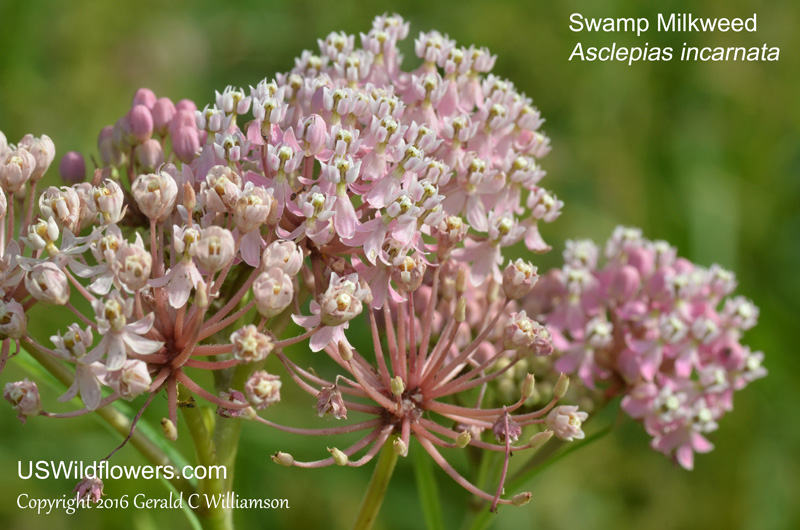
| | Site: I-64 Gateway Rest Area, St Clair County, IL Date: 2016-August-23 | Photographer: Gerald C Williamson
Nikon D7000 | | The Monarch butterfly relies on milkweed plants for survival. | | Click on the photo for a larger image
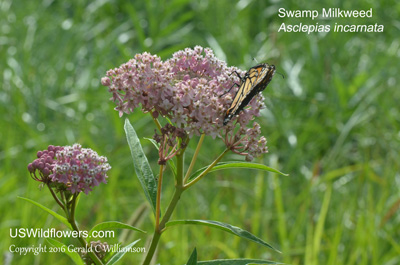
| | Site: I-64 Gateway Rest Area, St Clair County, IL Date: 2016-August-23 | Photographer: Gerald C Williamson
Nikon D7000 | | The Swamp Milkweed flower is shaped like that of most milkweeds, consisting of 5 upright pale hoods surrounding the horns, and 5 petals that reflex sharply downward. The petals are usually rosy-pink, but may be purple, nearly red, or white. | | Click on the photo for a larger image
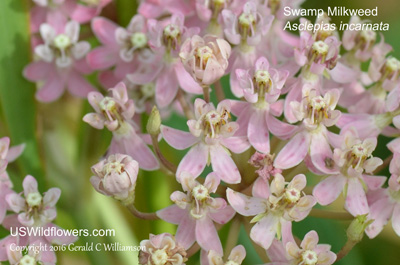
| | Site: I-64 Gateway Rest Area, St Clair County, IL Date: 2016-August-23 | Photographer: Gerald C Williamson
Nikon D7000 | | Asclepias incarnata grows to between 2 and 6 feet tall. Var. incarnata is usually branching, while var. pulchra rarely branches. The leaves are opposite, and carried on petioles between 1 and 4 inches long. | | Click on the photo for a larger image
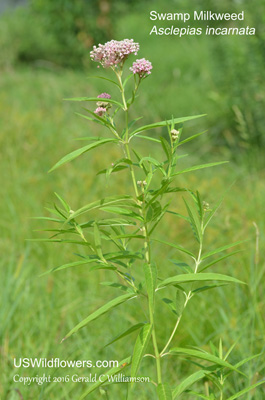
| | Site: I-64 Gateway Rest Area, St Clair County, IL Date: 2016-August-23 | Photographer: Gerald C Williamson
Nikon D7000 | | The leaf of Swamp Milkweed is usually lanceolate or ovate-lanceolate in shape, normally 4 to 6 times as long as they are wide. The margins are entire (smooth), the upper surface is usually medium to dark green, although aging or stressed plants may have yellowish leaves. The base of the leaf may be truncate or obtuse (var. incarnata,) rounded or cordate (var. pulchra). This specimen seems to have the narrow leaves and obtuse leaf base of var. incarnata. | | Click on the photo for a larger image
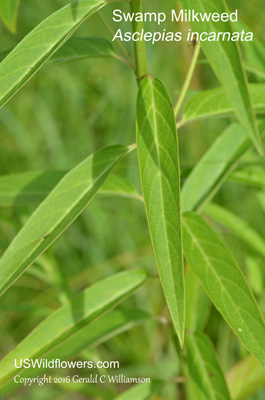
| | Site: I-64 Gateway Rest Area, St Clair County, IL Date: 2016-August-23 | Photographer: Gerald C Williamson
Nikon D7000 | | Bees are among the pollinators of Swamp Milkweed. | | Click on the photo for a larger image
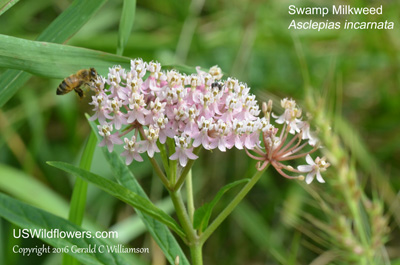
|
References used for identification and information:
|
|
| |
| #ad
|
|








